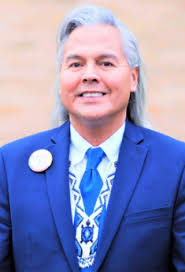
- Details
- By Aaron Payment
Guest Opinion. PART 2 of 3 On January 29, 2025, President Trump issued Executive Order–Expanding Educational Freedom and Opportunities for Families for which Section 7 which includes:
an examination of use of BIE funding for schools of choice options, including private, faith-based, or charter schools and assigns the Secretary of Interior to report on current performance of Bureau of Indian Education (BIE) schools and identify education options nearby which brings us to our purpose today. \
On February 28, in heeding the direction of the President’s executive order on Indian Education, the BIE transmitted a “Dear Tribal Leader Letter” to tribes to request consultation input on the following focus areas:
- Any available mechanisms that could provide families of eligible students use of Federal funding for educational options of their choice including how any such mechanisms will be funded;
- To the extent that there exist any such mechanisms to implement in the 2025-26 school years, the eligibility criteria for students in the plan referenced in the EO;
- Educational options near existing BIE-funded schools that could provide potentially eligible students local flexibility to attend a non-BIE school, such as a private, faith-based, or public charter schools.

Dr. Aaron Payment
As elected tribal leaders, both my Chairperson Austin Lowes (Sault Ste. Marie Tribe), and I attended both consultations on March 14th. Tribal and school leader testimony clearly showed that Tribal Nations do not support vouchers that will draw away tax payer resources from BIE Tribal grant schools. I provided testimony to show that losing even a small number of students will result in a loss of critically needed ISEP funding. A loss of 10% of the student count may mean a loss of an economy of scale that will result in insolvency of most BIE schools.Tribal leaders also complained in unison the lack of respect for scheduling a two-week window to prepare for consultation. Two weeks’ notice was insulting, paternalistic and foretold a foregone conclusion.
READ Part I: Indian Education as a Constitutional Right
Reae Part III Indian Education as a Constitutional Right
Indian Education as a Constitutional Right
Nonetheless, with a high school graduation rate disparity for American Indian and Alaska Native (AIAN) students essentially unchanged over the last 55 years, the need for education reform of public education is irrefutable. Perhaps Project 2025 and alignment of the Trump 2.0 Indian Education plan per the recent EO represents a new era of school choice for tribal nations.
According to the 2018 National Congress of American Indians Tribal Leader Took Kit: Education Choice for Indian Country – Supporting Tribal Decision Making for Schools and Students noted that in 2011, only 18% of AIAN fourth graders were proficient or advanced in reading on the National Assessment of Educational Progress (NEAP) as compared with 42% of their white counterparts. Only 17% of Native 8th graders were proficient in math, and nearly half were below the basic level. The numbers for white students were exactly the opposite with 17% below basic, and 43% proficient or advanced. Educational achievement for AIAN students at the local level can be even more dire, especially in rural reservation-area school districts, and in certain urban school districts with high concentrations of AIAN students.
Report after report—from the 1928 Meriam Report to the 1969 Kennedy Report, the 1991 Native Nations at Risk Report, the 2003 U.S. Commission on Civil Rights Quiet Crisis Report, the 2014 BIE Reform Report, the 2018 U.S. Commission on Civil Rights Broken Promises Report, and the Federal Indian Boarding School Initiative Investigative Report (Volume I in May 2022 and Volume II in July 2024)—have underscored the urgent need for true reform.
An Indian Education New Deal is essential to fully realize the intent of the 1975 Indian Self-Determination and Education Assistance Act (ISDEAA). The path forward has long been clear: to address the lasting impacts of forced assimilation and intergenerational trauma, tribal ownership of Indian education is imperative.
Dr. Payment currently serves on his Tribal Council. He previously served 22 years in office including four terms as Tribal Chairperson. He also served for nearly a decade on the National Congress of American Indians Executive Committee including at 1 st VP twice. A high school dropout, Dr. Payment earned five college degrees including doctorate in Education (EdD). He served as a university faculty teaching Native Studies/Political Science; as School Board President of a Tribal Grant and State Charter School; and as a Tribal College Board Regent Vice-President. Dr. Payment can be reached at [email protected]
More Stories Like This
Extending the Affordable Care Act Is a Moral Imperative for Indian CountryAll Is Fair in … War?
Why Federal Health Insurance Policy Matters to Cherokee Nation
The Absence of October's Job Report Shows Why Native American Communities Need Better Data
Tribal IDs Are Federally Recognized. ICE Agents Are Ignoring Them.
Help us defend tribal sovereignty.
At Native News Online, our mission is rooted in telling the stories that strengthen sovereignty and uplift Indigenous voices — not just at year’s end, but every single day.
Because of your generosity last year, we were able to keep our reporters on the ground in tribal communities, at national gatherings and in the halls of Congress — covering the issues that matter most to Indian Country: sovereignty, culture, education, health and economic opportunity.
That support sustained us through a tough year in 2025. Now, as we look to the year ahead, we need your help right now to ensure warrior journalism remains strong — reporting that defends tribal sovereignty, amplifies Native truth, and holds power accountable.
 The stakes couldn't be higher. Your support keeps Native voices heard, Native stories told and Native sovereignty defended.
The stakes couldn't be higher. Your support keeps Native voices heard, Native stories told and Native sovereignty defended.
Stand with Warrior Journalism today.
Levi Rickert (Potawatomi), Editor & Publisher

